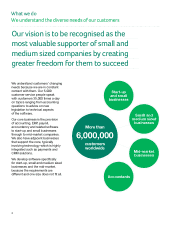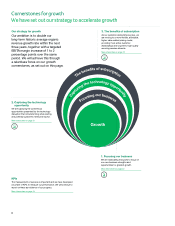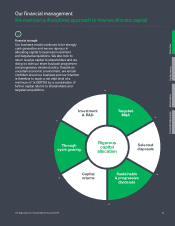Peachtree 2012 Annual Report Download - page 16
Download and view the complete annual report
Please find page 16 of the 2012 Peachtree annual report below. You can navigate through the pages in the report by either clicking on the pages listed below, or by using the keyword search tool below to find specific information within the annual report.
Chief Executive’s review
Creating freedom to succeed
There are three key areas where we are sharpening our focus on the core.
Firstly, we have undertaken a systematic review of our portfolio of businesses
to ensure it supports our strategy to accelerate growth. Proximity to Sage’s
core business and potential value creation are the principles used to assess the
strategic t of businesses within the portfolio and have guided our assessment
of both acquisitions and disposals during the year. The disposal of our
Healthcare business in the US and the acquisition of Folhamatic in Brazil
both illustrate this approach. The rigour with which this approach is applied
to our existing portfolio is also demonstrated by our identication of non-core
businesses. These non-core businesses constitute approximately 10% of
Group revenue.
Secondly, we are allocating investment to the most signicant initiatives which
will drive the Group’s growth. We have completed a comprehensive review
of our core business and have categorised our products as Invest, Harvest or
Sunset. This determines where resources are allocated and we are reallocating
R&D and sales and marketing resources to Invest products. We are reporting
these measures as a KPI to track progress on our reallocation programme with
2012 as the base year. For 2012, the split by category for R&D is 35% for
Invest, 53% for Harvest and 12% for Sunset and for sales and marketing
investment the split is 42%, 49% and 9% respectively. 2013 we will see
continued focus on reallocating investment towards Invest products. We have
also centralised R&D in North America, which is an important example of how
we are changing processes to accelerate our ability to align resources to our
priorities. It will take time for this programme to deliver in full, but the approach
to streamlining resources is embedded across the Group and will start to drive
accelerated growth.
The third key element of business focus is leveraging our global scale and
assets Sage One and Sage ERP X3 are examples of Invest products which
are global products in reach and where we are looking to leverage global
resources, capability and expertise to drive growth. Our technology strategy
is another important example of how we are investing in global platforms and
initiatives, whilst maintaining a focus on the end-user requirements of the local
market. This links in turn to our subscription strategy, where we are executing
with a global mindset, recognising that leveraging the knowledge of
subscription pricing disciplines across the business is vital to our success.
Capturing the technology opportunity
Our approach to technology is guided by the current and future needs of our
customers and the unrivalled position Sage enjoys to lead small and medium
sized companies to apply technology to best effect. It recognises that these
requirements differ by customer, by segment and by market and that
technology provides a catalyst for Sage to develop a more active relationship
with these customers, both existing and new. As important as leading our
customers is our focus on capturing the commercial opportunities resulting
from a more active customer relationship. We have invested signicantly in
Overview of the year
We delivered 2%* organic revenue growth in the year (2011: 4%*), which reects
a solid performance in the context of a macro-economic environment which
remained difcult in most of our markets. Growing organic subscription revenue
by 6%* evidences our ability to grow recurring revenue even in challenging market
conditions and the strength of our support offering to customers. The majority of
the contraction in SSRS was attributable to weak market conditions, particularly
in France and Spain with the shift to recurring revenue a factor in other markets.
We have also focused on disciplined resource allocation, protecting margins at
the same time as investing for growth. We are committed to driving strategic
change and I am pleased with the momentum we have established with our
growth initiatives.
A feature of the year has been the variable trading performance by geography.
The trading environment in Europe remained challenging during the year. Spain
has been the worst hit of our markets, and remains in deep recession, but
uncertain and deteriorating conditions in France also impacted performance.
The UK and Germany, by contrast, delivered strong revenue growth, notably
so relative to the economic backdrop. North America showed the anticipated
sequential improvement in the second half of the year, driven by good progress
with Sage Business Care and with Sage Payment Solutions. AAMEA continued
to deliver double digit revenue growth, with particularly strong growth in South
Africa and Africa more broadly. This variance in market conditions calls for
management discipline in allocating resources, directing investment to our
growth opportunities, such as Brazil and our Invest products, whilst protecting
protability in weaker markets such as Spain.
Strategy for growth
Accelerating growth remains our key priority. At our Investor Day in July 2012,
we set out our ambition to double our long-term historic average organic
revenue growth rate within the next three years, together with a targeted EBITA†
margin increase of 1 to 2 percentage points over the same period. The organic
growth plans are underpinned by three cornerstones and we have made solid
progress on these. We have developed a number of Key Performance
Indicators (“KPIs”) which reect the measures by which we are running the
business to deliver the cornerstones. Measurement is important and we will
continue to report on these KPIs as evidence of our progress.
Focusing our business
We are changing the way we run our business to capture the considerable
opportunities we have to accelerate growth from our core business. This
starts with a clear assessment of our core business, which is the provision
of accounting, ERP, payroll, accountancy and related products for customers
ranging in size from start-ups to mid-market companies. Importantly, we also
have adjacent businesses that support the core, typically involving technology
which is highly integrated such as payments and CRM solutions.
We remain condent we will
continue to deliver on our
strategic and nancial goals
# Organic gures exclude the contributions of current and prior year acquisitions, disposals and non-core products.
* Underlying gures neutralise the impact of foreign exchange movements and exclude amortisation of acquired intangible assets, acquisition-related items
and imputed interest.
† EBITA is dened as earnings before interest, tax, amortisation of acquired intangible assets and acquisition-related items and is after neutralising the impact
of foreign exchange movements.
14
























